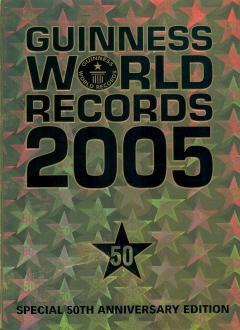
Edward Winter
In 1982 C.N. 164 reported that we had been in correspondence with the publishers of The Guinness Book of Records. The result was that a number of the book’s inaccuracies were corrected and, in particular, subsequent editions added an entry on Capablanca’s small number of losses in his adult career and his unbeaten record between 10 February 1916 and 21 March 1924.
How long Capablanca’s feat remained in the Guinness book we do not know, but certainly it was still there many years later. Before us lies the US paperback 1988 Guinness Book of World Records, which had a chess section some 70 lines long (pages 564-565). This also featured the most simultaneous chess games, the most consecutive games, the most blindfold games, the longest game, the slowest move, the earliest loss on time, the longest tenure of the world championship, the highest-ranked player, the most active world champion, the youngest world champion, various women’s records, and the longest recorded session of playing chess.

The other day we had the misfortune to come across the latest edition, Guinness World Records 2005 (London, 2004), and found that the chess content has been not so much dumbed down as drummed out. There is no chess section at all, the only references to the game being four brief entries under various headings.
In the ‘Toys’ section on page 108 (immediately following information on the ‘Longest Hot Wheels track’) comes this:
‘Largest chess piece
Mats Allanson (Sweden) has made a scaled-up king measuring 4m (13ft) high and 1.4m (4ft 6in) in diameter at the base.’
The next page (still the ‘Toys’ section) has:
‘Earliest chess pieces
‘Chessmen found at Nashipur, modern-day Bangladesh, have been dated to c. AD 900 and are the oldest known in existence.’
Then on page 110 (‘Games & pastimes’), just after the reader has been apprised of the ‘Farthest wink shot in tiddlywinks’, the following is offered:
‘Most opponents in consecutive chess games
Between 27 and 28 February 2001, Anna-Maria Botsari (Greece) played 1,102 consecutive [sic – simultaneous was meant] games of chess against different opponents, with just seven draws and the rest wins, at Kalavryta, Greece.’
That is the only reference to chess in the ‘Games & pastimes’ section.
Page 153 marks the final occasion when the existence of chess is acknowledged:
‘Largest networked chess computer
On 30 January 2004 Grand Master Peter Heine Nielsen (Denmark) played a game of chess against ChessBrain, the world’s largest networked chess computer. ChessBrain consisted of 2,070 computers located in 56 countries, which simultaneously combined their processing power.The match, which took place in Copenhagen, Denmark, ended in a draw after 34 moves.’
And that is it. Not one world-class chess master is mentioned by name. There is no indication that any championship title has ever existed. Indeed, the total space devoted to chess in the entire book is less than that accorded on page 113 to an exploit by Kathryn Ratcliffe (UK), who, on 25 October 2003 and with a tally of 138, broke her own record ‘for the most Smarties eaten in three minutes using chopsticks’.
(3493)
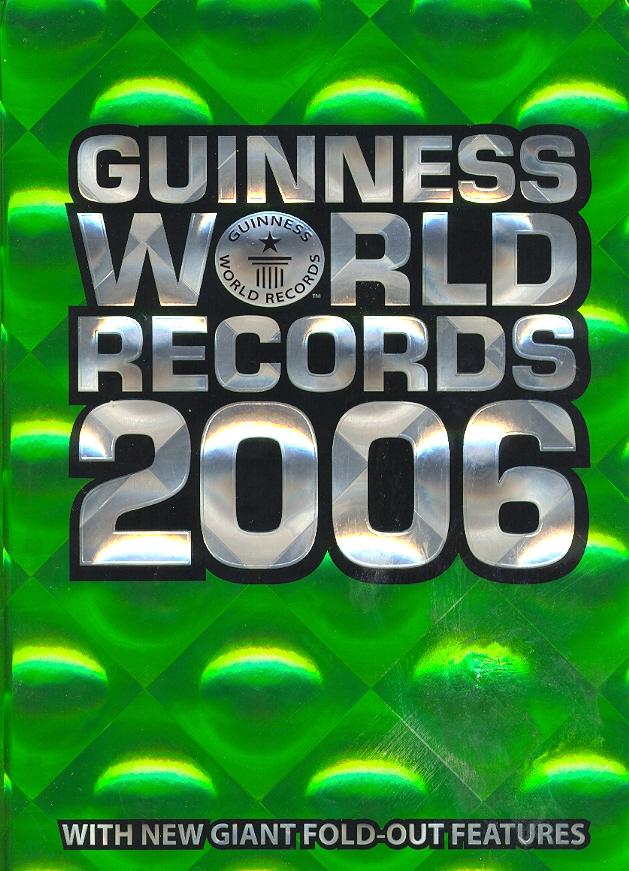
We now have before us the 2006 edition. Treatment of chess is still a far cry from what the book offered in past decades, but a modest start has been made in the right direction, with a chess section (page 46) comprising the following four items:
The book’s cut-off point seems to be spring 2005 for the inclusion of records and about 15 for the age of readers targeted.
(4035)
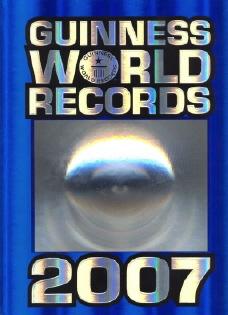
‘The world’s biggest-selling book’ is the boast on the back cover of Guinness World Records 2007 (London, 2006). Two pages include entries on chess: page 99 has a couple of dozen words about Sergei Karjakin being the youngest grandmaster, while page 137 offers brief features on the smallest and largest chess sets, as well as the following: ‘On 25 June 2005, 12,388 simultaneous games of chess were played at the Ben Gurion Cultural Park in Pachuca, Hidalgo, Mexico.’ That is all. The four entries from the 2006 edition have been dropped.
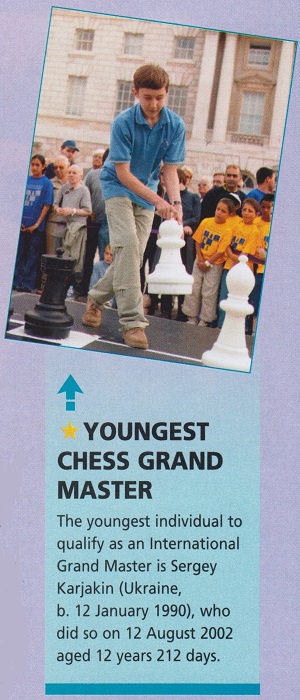
Guinness World Records 2007, page 99
Although poker has five entries on page 136, games such as draughts and bridge receive no treatment at all, and the editorial team’s interests are evidently on a different plane. For example, pages 8-9 document such pivotal attainments as ‘most heads shaved in 24 hours’, ‘fastest time to drink a 500-ml milkshake’, ‘longest tandem bungee jump’, ‘fastest carrot chopping’, ‘largest underpants’, ‘most socks worn on one foot’ and ‘fastest person with a pricing gun’.
(4682)
From an article ‘Densa and Densa’ (chessville.com) by Raymond Keene (posted on the Internet on 21 September 2008):
‘I therefore decided to take a look for myself to ascertain whether Guinness is dumbing down or not, and to discover if their response is an honest appraisal of the situation or pure hypocritical cant?
“The world’s biggest-selling book” is the boast on the back cover of “Guinness World Records 2007”. Seven pages in total include entries on Mind Sports: a couple of dozen words about Sergei Karjakin being the youngest chess Grandmaster, while another page offers brief features on the smallest and largest chess sets, as well as the following: “On 25 June 2005, 13,388 simultaneous games of chess were played at the Ben Gurion Cultural Park in Pachuca, Hidalgo, Mexico.”
Although poker has five entries, games such as draughts and bridge receive no treatment at all. For example, it documents such pivotal attainments as “most heads shaved in 24 hours”; “fastest time to drink a 500ml milkshake”; “longest tandem bungee jump”; “fastest carrot chopping”; “largest underpants”; “most socks worn on one foot” and “fastest person with a pricing gun”.
(5771)
Raymond Keene’s plagiarism of our work (C.N.s 3493 and 4682) at chessville.com:
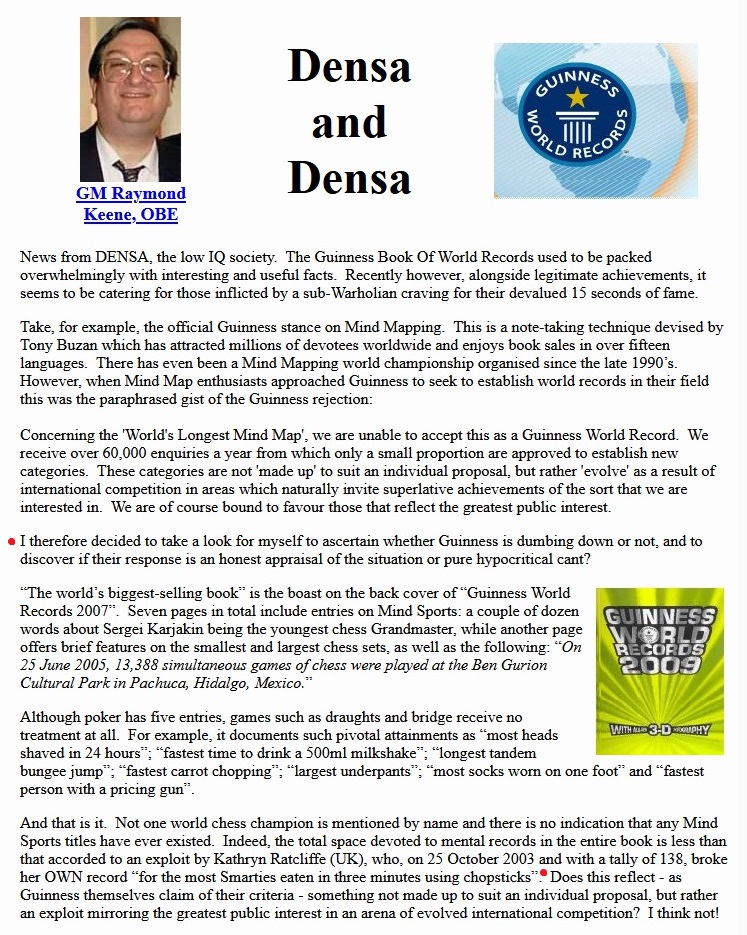
The image below highlights in red the only bits written by Mr Keene when he tried to pass off our writing as his own:
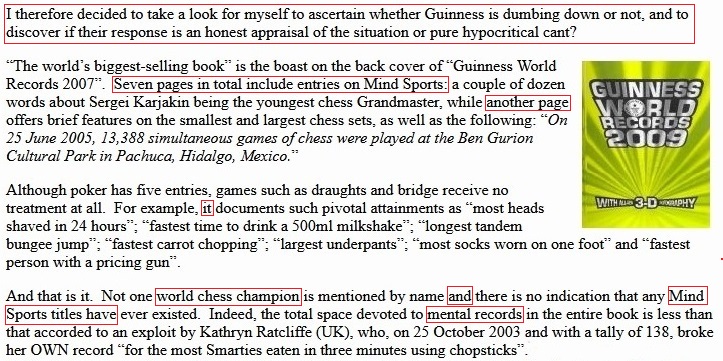
C.N. 5771 demonstrated that the text of our item C.N. 4682 (written two years ago) was recently lifted by Mr Raymond Keene for use under his own name in an article on the book Guinness World Records.
The matter has been investigated in detail at the website of the Streatham & Brixton Chess Club (reports dated 30 September, 8 October and 10 October 2008). It may be noted, in particular, that:
a) Mr Keene has made various attempts to explain his copying, and they have been proven untrue;
b) The website to which we referred in C.N. 5771 has now removed from Mr Keene’s article our paragraphs about chess;
c) Mr Keene’s article originally appeared in his weekly column in The Spectator (page 64 of the 7 June 2008 issue);
d) Over a third of ‘his’ article in The Spectator was, in fact, written by us.
(5795)
Below is Mr Keene’s column with our text blacked out:
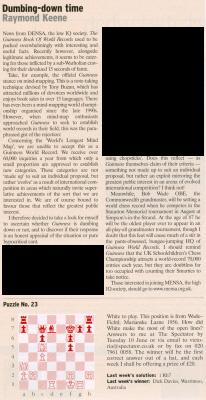
Our writing as it appeared in The Spectator:
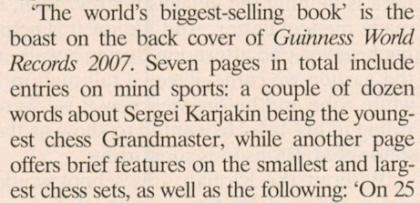
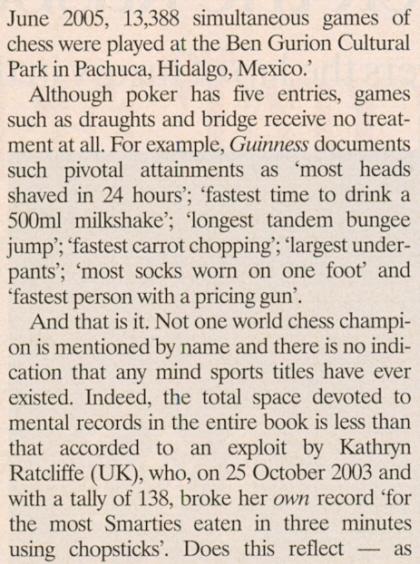
As reported in C.N. 9178, on page 139 of his book The Official Biography of Tony Buzan (Croydon, 2013) Raymond Keene plagiarized our work again:
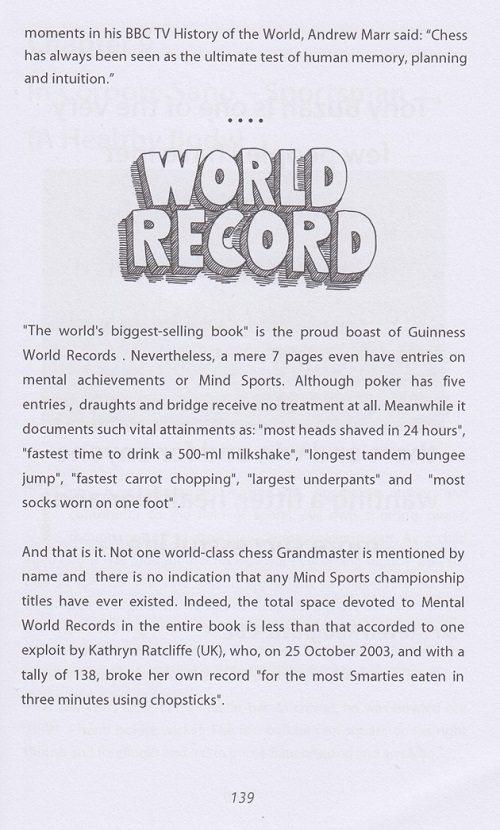
See too Copying.
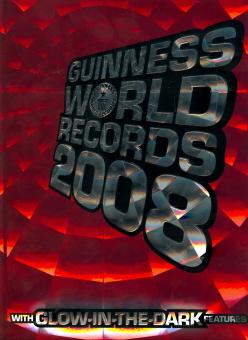
Our annual report on the chess content of the book Guinness World Records is, for the 2008 edition, of record brevity: there is no chess content.
(5237)
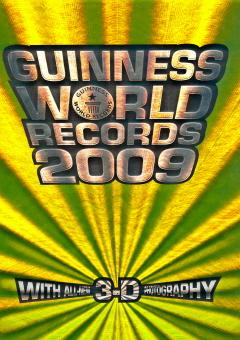
The index of Guinness World Records 2009 (London, 2008) includes only one reference to chess – page 264 – but it is page 263 which has the book’s solitary entry about the game: some 20 words on Sergei Karjakin (Ukraine) having become the youngest grandmaster in 2002.
That appears in a section entitled ‘Eastern & Central Europe’, and also on page 263 the reader is apprised of correspondingly impressive accomplishments in Estonia (‘largest matchstick’) and in Romania (‘longest chain of condoms’).
(5763)
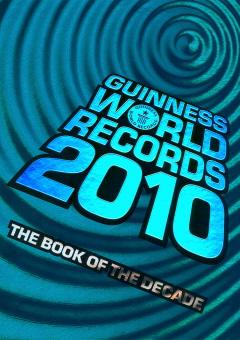
The 2010 volume of Guinness World Records has a scattering of but three chess entries:
Grand total: 14 lines. The combined items receive considerably less space than, for instance, the illustrated feature on page 161 regarding a German who, in two minutes, ‘removed 26 garter belts from the legs of willing volunteers using just his teeth’.
(6330)
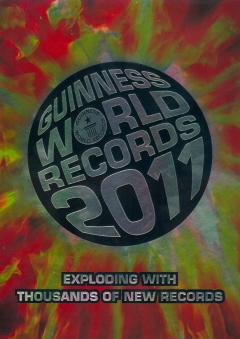
The 2011 edition of Guinness World Records has three items on chess: on page 74, a reference to the 269-move game listed in the 2006 volume; on page 146, three lines plus a photograph regarding Morteza Mahjoob’s 500-board simultaneous display in 2009 (see Chess Records); on page 204, a reference to the largest chess set.
The chess set (Canadian) is only slightly larger than the one from California recorded in the 2007 volume and hardly seems a sensational record-holder. The board, on each side, is 5.89m, and the king is 1.19m tall and 37.4cm wide.
(6775)
C.N. 3493 referred to the US paperback 1988 Guinness Book of World Records. Its chess coverage (pages 564-565):
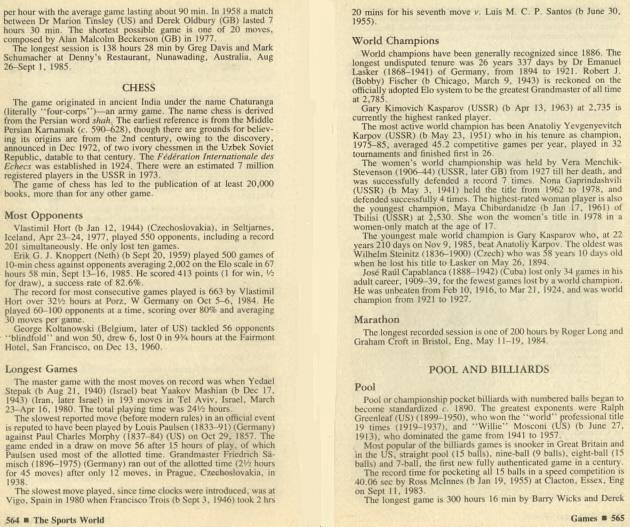
Weighing about four times as much, Guinness World Records 2012 has one entry on chess (‘Most games of chess played simultaneously in one location’), with two photographs (page 154).
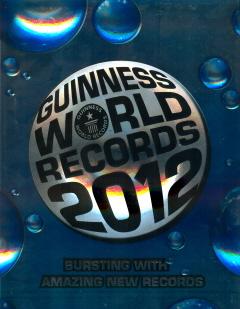
Elsewhere (page 265) there is an entry on ‘the first Chess Boxing World Championship’, referring to an event in 2003. At least that is relegated to a section headed ‘Sporting Madness’, alongside reports on the Winkle Spitting World Championship, the UK Mobile Throwing Championships and the Mashed Potato Wrestling Championships.
(7281)
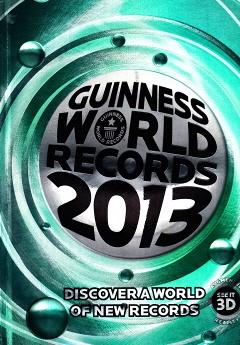
Guinness World Records 2013 has three entries concerning chess. Page 106 offers a reprise of an old item about Karjakin (the youngest grandmaster), and page 197 refers to Kasparov’s loss to Deep Blue in 1997. True to the Guinness tradition, page 109 has a light feature on the Cotswold Olimpicks of 1612, a competition involving this ‘range of rather curious disciplines’: dancing, chess, cockfighting, jumping in sacks, pike drill, shin kicking, spurning the barre and hay bale racing.
(7782)
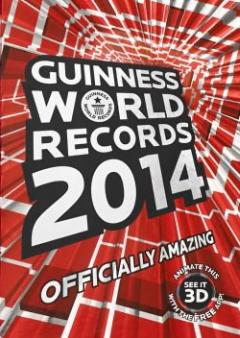
The uncongenial annual task of reporting on Guinness World Records is upon us again. The 2014 edition (senselessly described on the front cover as ‘officially amazing’) has only three chess-related entries, the first of them on page 61:
‘Simultaneous blindfolded chess wins
In 1947, legendary chess player Miguel Najdorf (Argentina) took on 45 players, holding each game simultaneously in his head. Over 23 hr 25 min he won 39, drew four and lost two. Najdorf had been forced to leave his family in Poland at the start of World War II. All died in concentration camps, but Najdorf hoped that if he broke a record news might reach survivors. He was never contacted.’
Page 96 has a feature on ‘largest toys’ which shows a king 4 metres 46 high with a diameter of 1 metre 83 around the base (St Louis, MO, USA, 24 April 2012).
Finally, page 111 recounts a feat which seems readily beatable:
‘Mehak Gul (Pakistan) sorted a chess set into the opening set-up for a game in 45.48 seconds during the Punjab Youth Festival at Expo Centre Lahore in Pakistan, on 21 October 2012.’
Other achievements related on that same page include ‘Most toothpicks in a beard’, ‘Most mousetraps released on the tongue in one minute’, ‘Most underpants pulled on’, ‘Most rubber bands stretched over the face’ and ‘Longest time spinning a basketball on a toothbrush’.
(8313)

The 2015 edition of Guinness World Records has slightly more chess material than usual. Under the heading ‘Chess master’ in the ‘Oldest people’ section, page 77 mentions Zoltan Sarosy, who ‘continues to play at 107 years of age’. Page 110 (‘Indoor pursuits’) has little items not only on the ‘Largest plastic-cup pyramid in 30 minutes’ but also on the ‘Fastest time to arrange a chess set’, ‘Longest chess marathon’, ‘Most chess games played in one location’ and ‘Largest chess set’. Kasparov’s defeat by Deep Blue in 1997 is mentioned on a page (204) which is entitled ‘Robots & Al’ and has the heading ‘In the Middle East, robot jockeys are replacing children in camel racing’.
(8851)
A FIDE report [more recent link] dated 13 March 2015 (richly illustrated but poorly written) stated:
‘On March 11, the FIDE President left Reykjavik for London where he visited the editorial office of the Guinness World Records and congratulated the Records with its 60th anniversary. The talks were about the possible cooperation between FIDE and Records that meets the interests of both sides. The Records’ representatives would like to get the various information about chess and proposed to set the necessary criteria for the certification of records and their submission for publishing.’
In two photographs Kirsan Ilyumzhinov beamingly held a copy of Guinness World Records 2015.
Since 2004 we have been posting annual accounts of the chess content of Guinness World Records, and it can now be mentioned that the 2016 book has just been published.

Number of chess-related items in the 2016 edition: zero.
(9481)
Page 11 of the 7/2015 New in Chess had an item on Guinness World Records, mentioning our yearly reports and Raymond Keene’s plagiarism of C.N. 4682 in the Spectator. (As so often, Mr Keene escaped being named; the reference was just to ‘a certain English chess journalist’.) The main thrust of the New in Chess feature was the absence of any chess content in the 2016 Guinness World Records volume despite Kirsan Ilyumzhinov’s contact with the company, and it all gave the impression of supplementing our own observations. In reality, New in Chess was merely repeating the very point made in C.N. 9481.
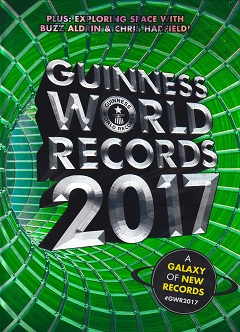
Annually since 2004 we have offered reports on the chess coverage – whether trivial, minuscule or non-existent – in Guinness World Records. The 2017 edition has just been received and is spectacularly different: chess receives a two-page spread.
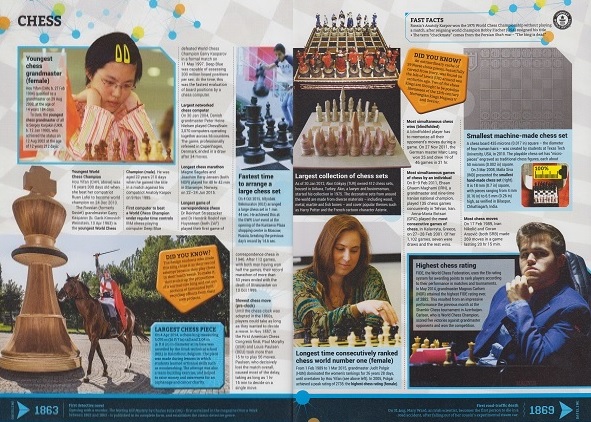
The topics on pages 144-145 are:
There are also brief ‘fast facts’ and ‘did you know?’ items about: design students who made a large king; the Isle of Lewis chessmen; Karpov/Fischer in 1975; the origin of the term ‘checkmate’.
(10110)
The 2018 Guinness World Records is now to hand. After the two pages for chess last year (C.N. 10110), how would the game fare in the new book (promoted on the back cover as ‘The super-est edition yet!’)?

The answer is that chess is back to where it was two years ago: nothing.
In compensation, the reader will find entries on such feats as the ‘most flowers picked with the mouth in a contortion backbend in one minute’, the largest collection of ‘banana-related memorabilia’, the most ‘cream-filled biscuits stacked in 30 seconds’, the ‘most shuttlecocks caught with chopsticks in one minute’, the ‘largest online photo album of people giving a thumbs-up’, the ‘most valuable bra’, the ‘first written record of black pudding’ and the ‘largest origami rhinoceros’.
(10596)
‘On 17 July 2013, Garry Turner (UK) attached 161 clothes pegs to his face on the set of Rekorlar Dünyasi in Istanbul, Turkey.’
A photograph of Mr Turner’s head, virtually hidden by the attachments, takes up much of page 93 of Guinness World Records 2019 (London, 2018). The book has scores, if not hundreds, of similar items, and especially in the gross ‘Food Feats’ section.
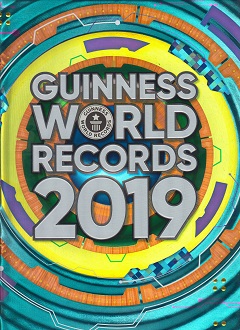
In our annual doleful duty, we note that the 2019 edition has an index entry for clothes pegs but not for chess. However, the latter is mentioned twice in the ‘Stop Press’ section on pages 254-255:
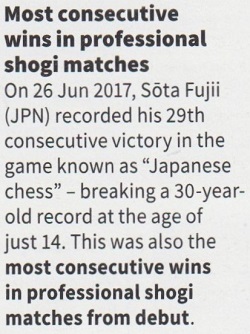
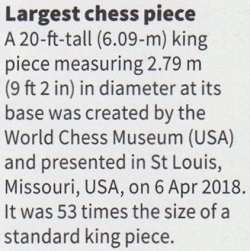
(11018)
In conclusion, C.N. 11018 asked for detailed information about the rook in the playing area of the 1974 Olympiad in Nice. Five photographs were shown, including one from page 291 of the August 1974 BCM:
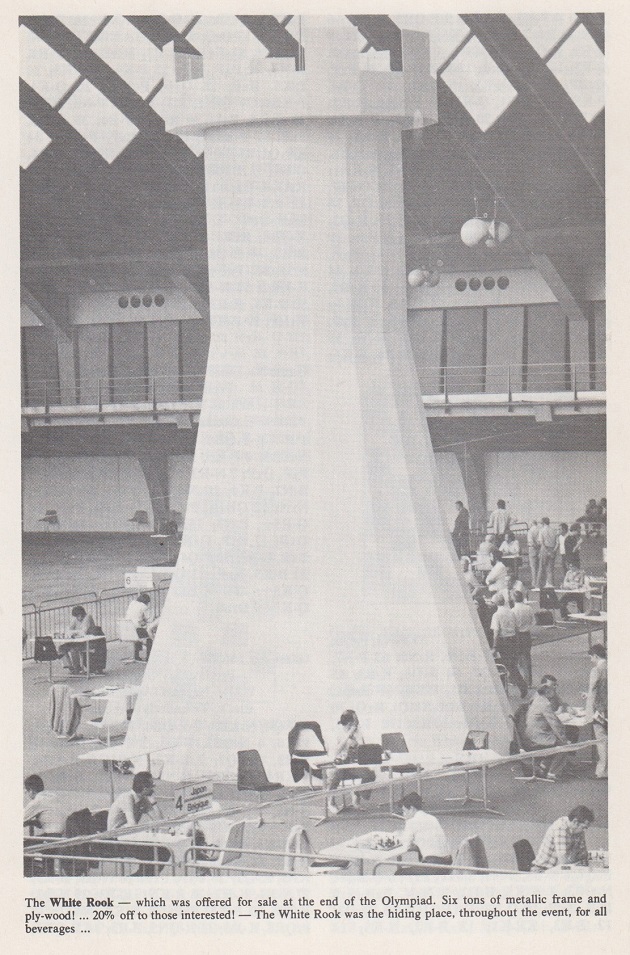
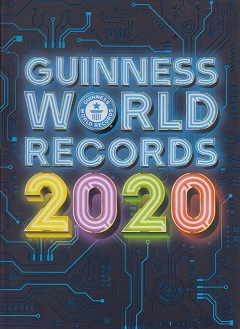
The 2020 edition of Guinness World Records, just published, has four chess entries:
It may be mentioned à sa décharge that the Guinness company has, in addition to its books, a website with a database featuring many chess-related exploits.
Claims concerning alleged simultaneous displays by Dimitrije Bjelica (Sarajevo, 1982 and Subotica, 1997) are discussed in C.N. 11591.
New editions of the book Guinness World Records are no longer monitored here but, as mentioned in C.N. 11540, the Guinness company has a database which includes many chess-related exploits. One of them, dated 2020, is headed ‘Smallest handmade chess set’.
For purposes of comparison, below is C.N. 377 (written in 1983):
A report in the Tribune de Genève of 1 February 1983 says that five students at the Ecole d’ingénieur de Genève (Philippe Cantin, Jean-Marie Croisier, Robertino Noventa, David Ribaut and Marc Schmidt) have made what is thought to be the smallest chess set in the world. The peg-in board measures 8 mm by 8 mm; the size including the border frame is 12 mm x 12 mm. Each square is 1 square mm, the pawns are 1.5 mm high, while the tallest piece, the king, measures 2.5 mm. An actual game can be played with it. Four hundred hours of work went into it, and the Livre des records is now doing its research to try to establish whether this is indeed a world record.
The chess set was referred to on the front page of the Geneva newspaper, and the detailed report, by Jean-Noël Cuénod, was on page 9:
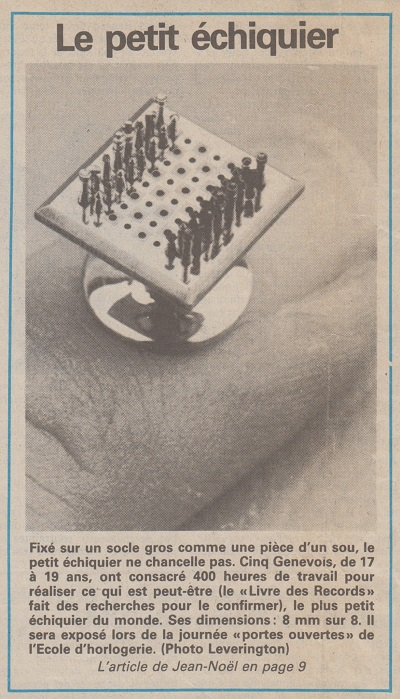
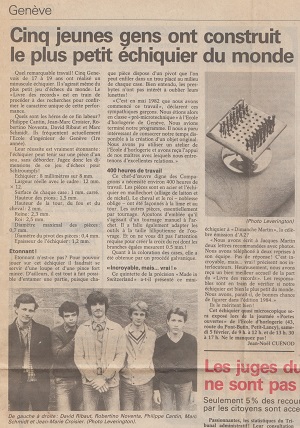
(11822)
The annual volumes are no longer being monitored.
Related article: Chess
Records
To the Chess Notes main page.
To the Archives for other feature articles.
Copyright: Edward Winter. All rights reserved.